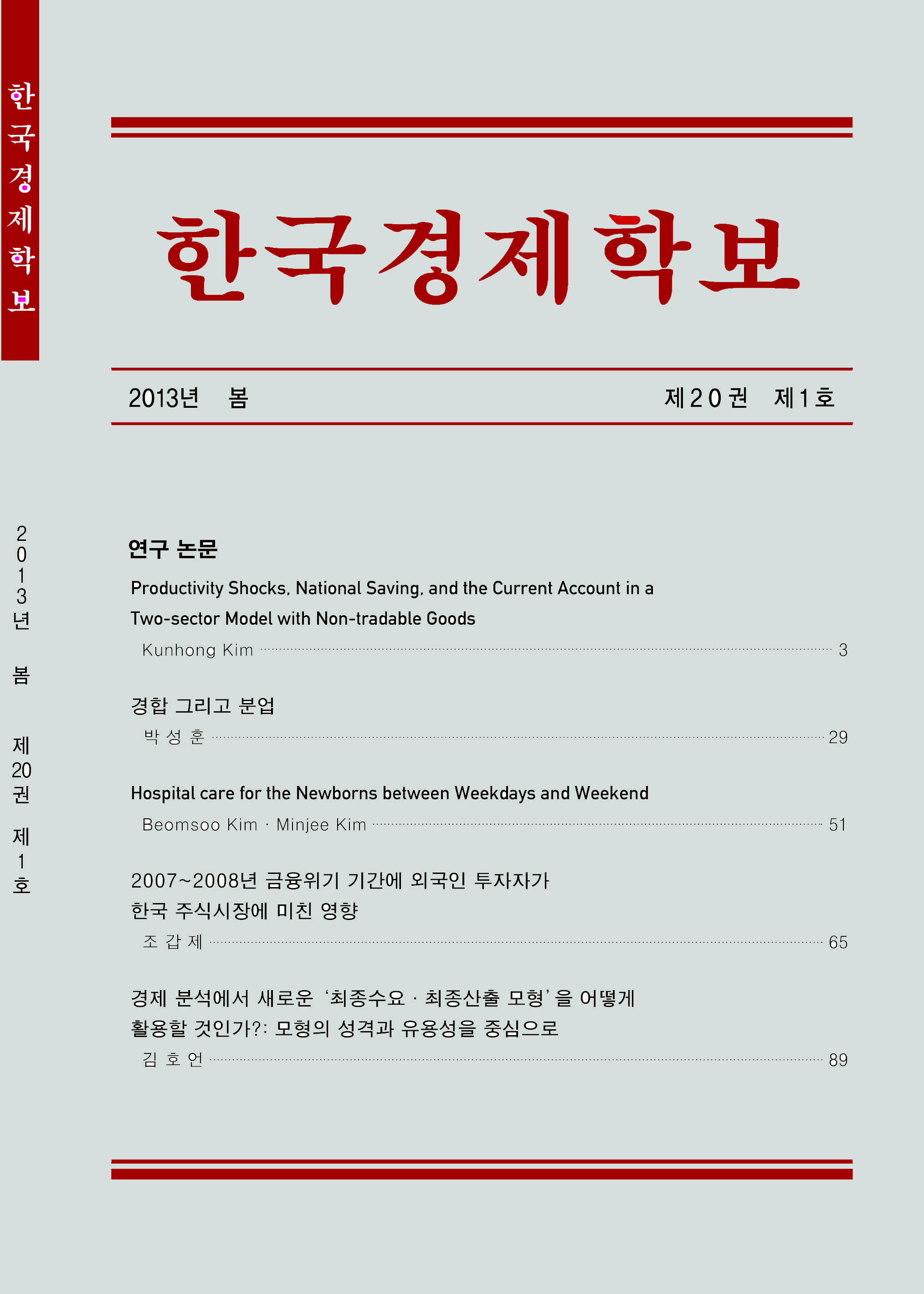
한국경제학보 제 7권, 제 1호 (2000년 봄)
연구논문
윤기중
Pages 5-42
-
Abstract || PDF
- 본 연구는 오랫동안 이용·적용해 오던 소득분배에 대한 가치기준, 소득분포의 불평등도 변동이론, 불평등의 척도 그리고 한국의 불평등에 대하여 재검토하고자 하는 것이다. 우선, 과거 공리주의의 가치에서 로울즈 정의론으로, 불평등의 변동에 대한 쿠즈넬츠 이론에서 경제학적 원인 분석에 대한 재검토, 불평등에 대한 기술적 척도에서 규범적 척도로 그리고 한국의 불평등 변동 양상과 계측에 관한 자료를 분석·검토하고 그 결과에 따라 몇 가지 제언을 하고자 한다.
Suk Bum Yoon
Pages 43-52
-
Abstract || PDF
- The per capita regional income and wealth distributions in Korea are highly equal over time. and the shifts in ranking of both per capita Income and wealth levels are extensive, even though the differences are minimal. A production function estimated from regional cross-section statistics shows a rigid elasticity of substitution between labor and capital in Korea.
백준봉
Pages 53-85
-
Abstract || PDF
- 제도를 주어진 여건으로 간주하고, 가격기구를 통한 경제활동의 조정 빛 배분적 효율성을 강조하는 저통적인 신고전학파와 경제학과 달리 최근 20여 년간 제도 및 제도변화를 내생적으로 설명하려는 제도경제학 연구가 활발하게 진행되었다. 제도연구라는 공통의 관심사에도 불구하고, 이러한 연구경얀 단일한 착하라고 할 수 없는, 다양한 이론적 흐름으로 구성되어 있다. 본 연구는 제도경제학의 일반적인 특징을 살펴보고, 다양한 제도경제학의 연구조류들을 분석 대상, 방법론 그리고 제도진화의 원리를 중심으로 분류·비교한다. 이는 제도경제학의 제조류간 상호교류를 위한 전제작업으로서, 나아가 경제학의 범위 및 분석능력을 확장하는 계기로서의 의의를 가질 수 있다.
김학은
Pages 87-100
-
Abstract || PDF
- 본 논문은 애로우의 불가능성 정리에 적절한 제약조건을 허락하여 사회무차별함수가 존재한다 하여도 또 하나의 불가능성이 존재할 수 있는 가능성에 대한 실험적 소고이다. 유량변수는 단위 시간에 측정하는 크기이다. 대부분의 경제분석은 여기에 근거를 두고 있다. 반대로 유량변수의 역수는 단위 유량변구의 흐름을 측정하는 시간이다. 따라서, 모든 경제분석의 결과는 변수전환에 근거를 둔 분석의 결과와 일치해야 한다. 이점에 있어서 단순한 비교정태분석은 심각한 문제를 일으키다. 이것이 2차 불가능성의 근원이 될 수 있다.
Youngse Kim
Pages 101-119
-
Abstract || PDF
- We re-examine subjects' behavior in the ultimatum bargaining experiments studied by Roth et al. [24]. In our model, un-modeled factors including rationality determine players' initial aspirations, and a modified version of case-based learning process governs subsequent adaptations.
The calibration results of this paper show that "satisficing" can explain the actual subjects' behavior surprisingly well. More precisely. it is shown that 77.7 to 96.7% of the observed behaviour is consistent with our model prediction. We also argue that the closer are the initial aspiration levels to the perfect equilibrium payoff, the lower is the mean or modal offer in the actual experiments.
강의자료
The Korean Journal of Economics, Vol. 7, No. 1 (Spring 2000)


